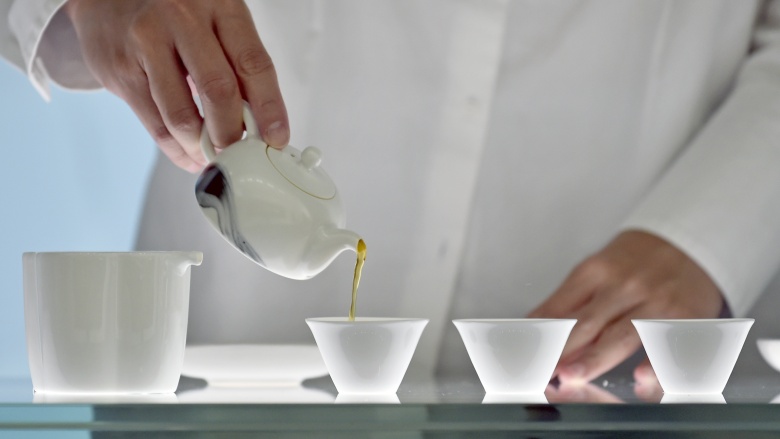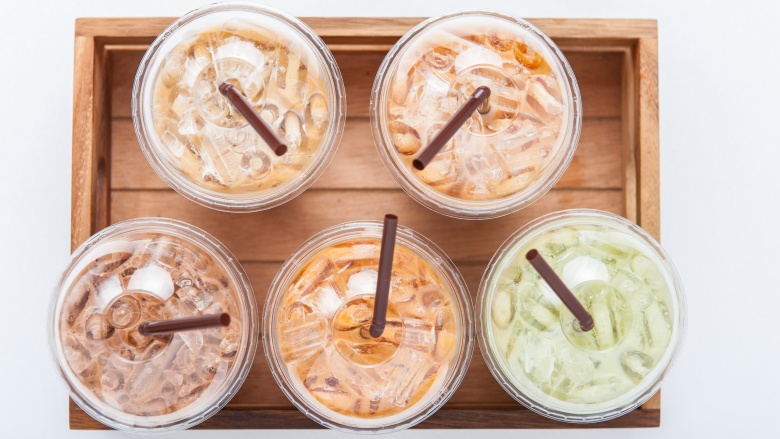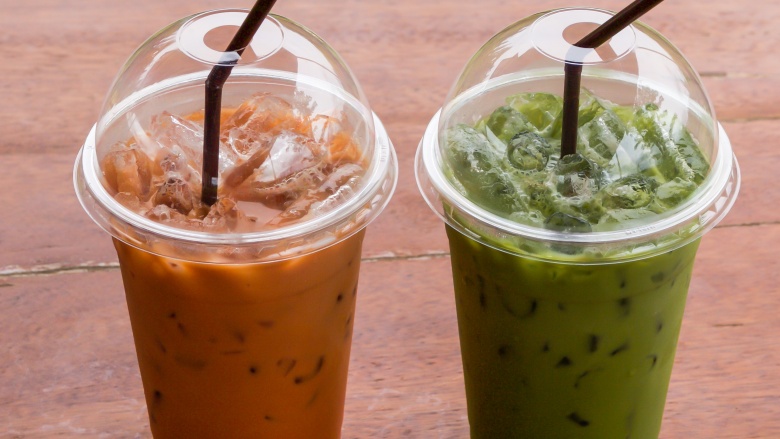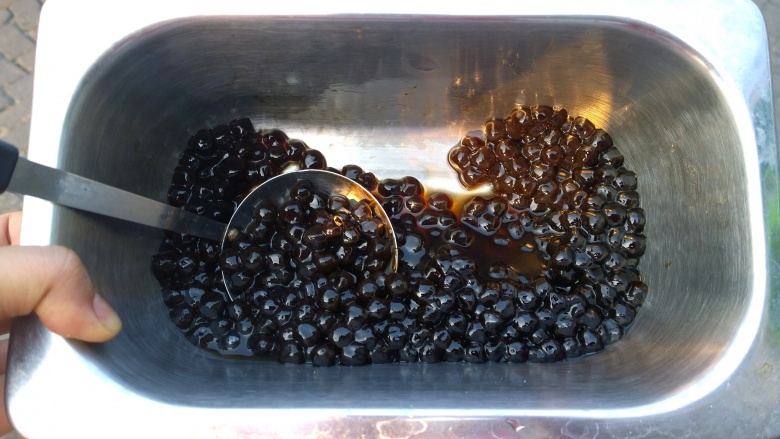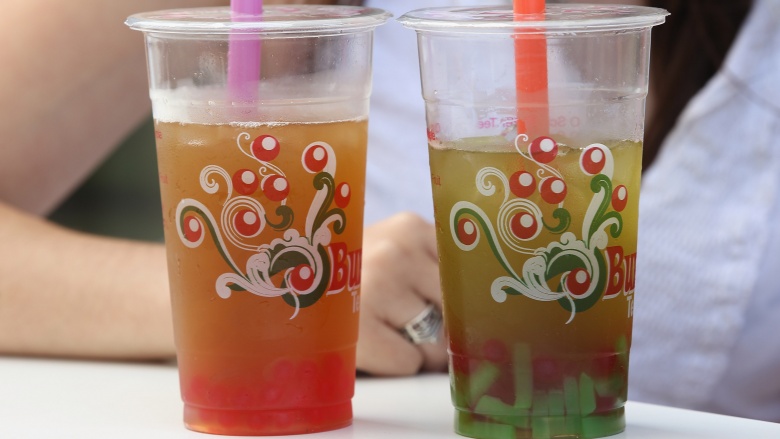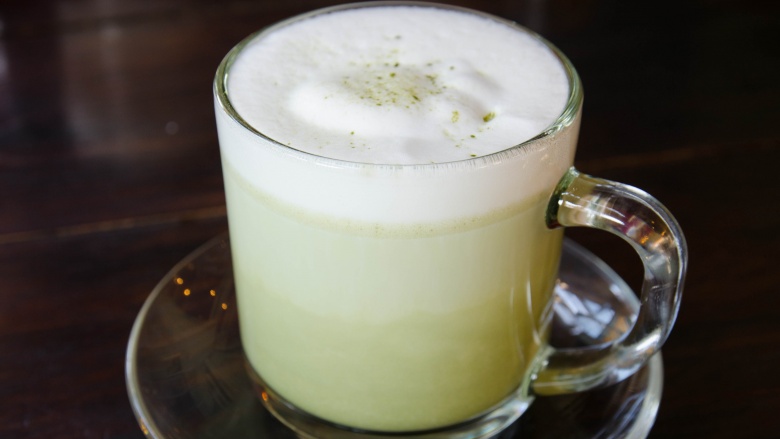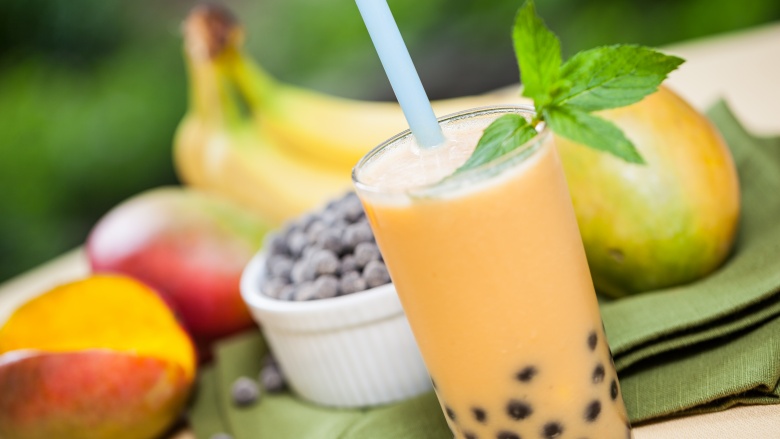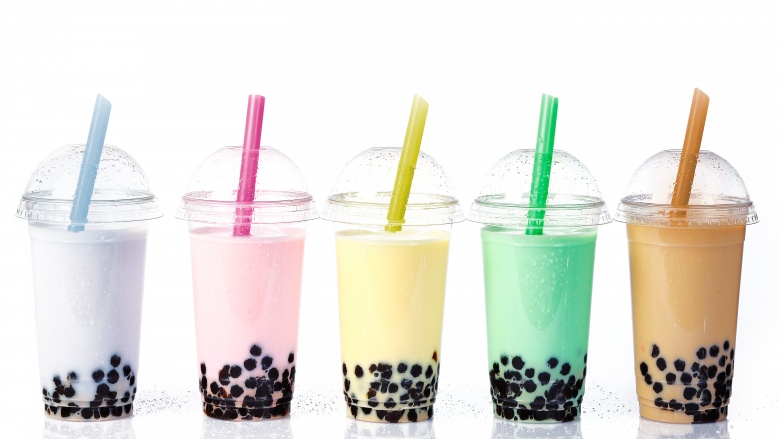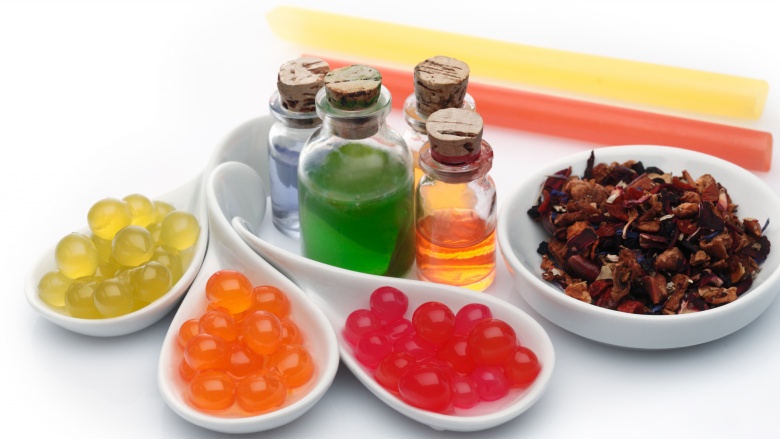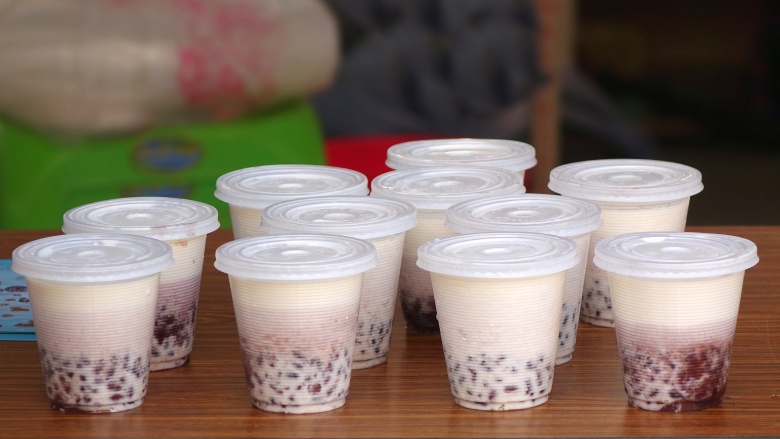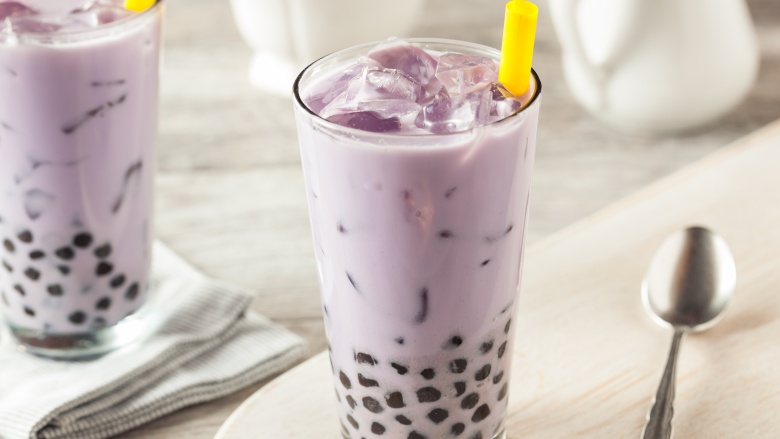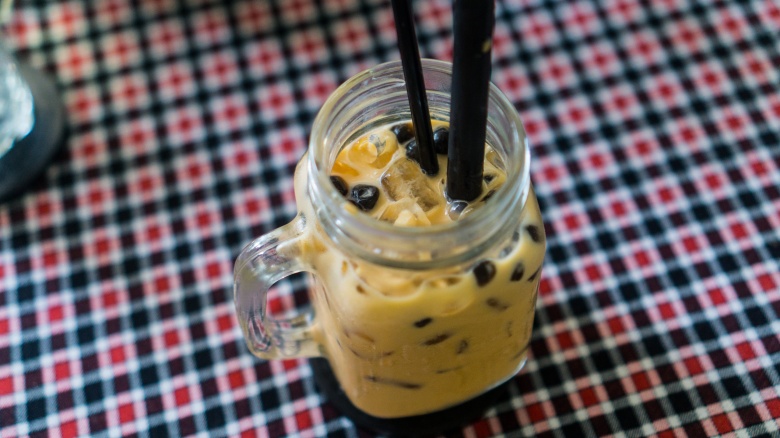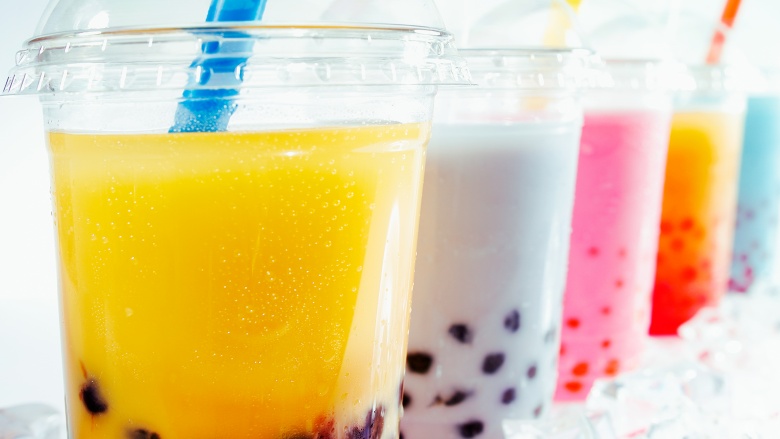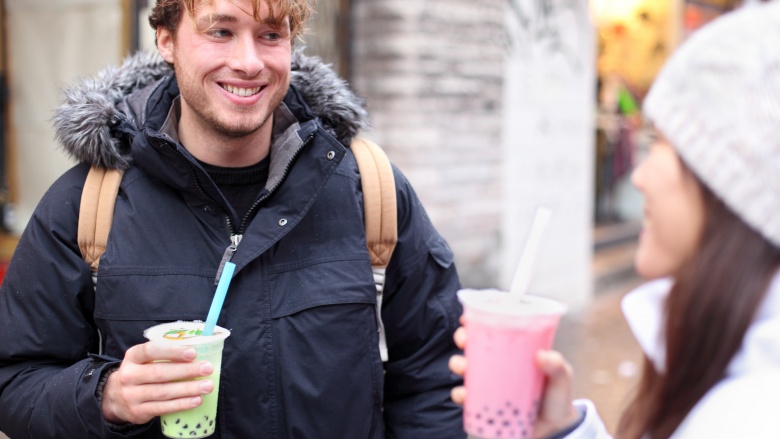Things You Didn't Know About Bubble Tea
Bubble tea, which enjoyed brief popularity in the United States in the late 2000s, made a comeback in 2016, according to NPR. Recognizable to many people by the tapioca balls at the bottom and the wide straws that allow you to sip them along with your tea, you probably know bubble tea when you see it. But how much do you really know about bubble tea? These facts about bubble tea's history, ingredients, and health risks might surprise you.
Who invented it and why?
Bubble tea is a Taiwanese tea-based drink invented in Taichung in the 1980s. As the story goes, Lin Hsiu Hui got bored during a meeting and poured her tapioca dessert into her tea. It turns out it was delicious! It probably wouldn't have worked if Lin Hsiu Hui wasn't already the product development manager for Chun Shui Tang teahouse in Taichung, Taiwan. The founder of the teahouse first came up with the idea of serving traditionally hot Chinese tea cold in the early 1980s after seeing coffee served cold in Japan. Cold tea and sweetened syrup, plus chewy tapioca balls — and the rest is history.
Bubble doesn't refer to the tapioca
Even though Lin Hsiu Hui first created bubble tea by adding tapioca balls into her tea, the "bubble" in bubble tea actually refers to the oxygen pockets formed by shaking the tea. It's likely that these same bubbles formed when she first poured her tapioca dessert into her tea during that fateful, boring meeting when she invented it. This is also why you can get bubble tea without any tapioca. What makes it bubble tea is the shake or blending that causes bubbles at the top.
What's in a name?
It shouldn't come as a surprise that because the bubbles refer specifically to the shaking and oxygen bubbles in the tea, you might find bubble tea by many other names that describe aspects of the drink. Milk tea, pearl tea, tapioca tea, boba tea, boba nai cha, foam milk tea, momi milk tea, and Q (or QQ), which means chewy, are a few of the variations. While many American shops use boba tea and bubble tea interchangeably (with more references to boba on the West Coast), it has more to do with the size of the tapioca.
Evolution of tapioca size
The size of the tapioca in bubble tea can vary. This explains a few of the different names for the tea. Pearl tea refers to the original bubble tea with smaller tapioca ("pearls"). Boba tea, on the other hand, refers to the bubble tea with larger pearls ("boba"). Because the small pearls are typically used in desserts like the one Lin Hsiu Hui poured into her tea in the 1980s, we might say that small pearls are the traditional style for bubble tea, though now almost all shops use the larger boba.
Tapioca isn't the only option
If you want something chewy in your bubble tea but don't like tapioca, no problem! Other options for the jelly-like balls include grass jelly, konjac jelly, or nata de coco (a high fiber, coconut based jelly). You can also get popping boba, which is made from a seaweed extract with fruit juice flavoring inside that pops open once bitten into. Some shops even offer puddings or beans as a tapioca-alternative.
Temperature and tea customization
You may have mostly had bubble tea in its cold form, but you aren't limited to what has become known as the traditional style. If you're craving bubble tea in the freezing winter, you can find it available in hot varieties to help warm you up. If you like it cold, but you're looking for something a little thicker, it's also available as a smoothie. Another option for customizing it is by choosing the type of tea. Some shops offer lots of options, including green, black, oolong, and sometimes even Thai and chai tea. Pick your favorite variety and go from there.
It can be made vegan
Tea and temperature aren't the only things you can customize in bubble tea. Despite carrying the name "milk tea" in some regions and circles, no one specified that the milk had to be dairy milk. Non-dairy alternatives, such as almond milk, soy milk, and coconut milk, can be substituted, especially if you make your bubble tea at home. Since tapioca (and many of the alternatives) are plant-based, this means you can have an entirely vegan bubble tea experience at many locations. Just make sure you ask at your favorite shop, because some flavors of bubble tea come pre-mixed with dairy ingredients.
It comes in many flavors
Maybe you're thinking that you'd like to try bubble tea, but you're not a fan of the flavor of tea (of any variety). Have no fear! Bubble tea comes in a huge variety of additional flavors: everything from pina colada and chocolate banana to cappuccino and tiramisu, and just about everything in between. The options are seemingly endless. At some shops you can even get bubble tea made with real fruit and all natural ingredients. So if what you're craving is less of a cookie and more of a mango, bubble tea still has you covered.
It isn't all that healthy
Because the boba are most often made with tapioca starch, bubble tea isn't exactly low-calorie. While tapioca boba are fat-free, bubble tea is loaded with empty calories and, depending on the milk used, potentially also fat. Many of the empty calories are because the tapioca starch is all carbohydrates, and not the complex carbs that are healthy and found in whole grains. These carbs have almost no nutritional value. Pair that with the fat in your milk choice and the extra calories and carbs that come in the sugary, flavored syrups, and bubble tea can easily top 300 to 400 calories with more than 50 grams of carbs, according to nutrition-tracking apps like MyFitnessPal.
There have been other health concerns
In May 2011, a food scandal broke out in Taiwan where the palm oil in some drinks and syrups (including some that may have been exported and used in bubble tea shops around the world) was replaced with diethylhexyl-phthalate (DEHP), which is a chemical often used in plastics to make them pliable. DEHP is considered a potential carcinogen in humans after researchers found that it was a carcinogen in rats. The researchers noted, however, that further studies needed to be done to test the effect of small doses of DEHP in humans, such as what would be obtained through the casual drinking of bubble tea.
The risks may have been overblown
Another report published by the Rheinische Post after the diethylhexyl-phthalate scandal broke out said that samples of bubble tea contained other carcinogenic chemicals, such as styrene, acetophenone and brominated substances. That same year, however, Taiwan's Food and Drug Administration confirmed that a second round of tests conducted by German authorities found no cancer-causing chemicals in bubble tea. Whether this means that the original samples were tainted in some way or that the levels of chemicals vary from sample to sample is unknown, but there has been no further indication that bubble tea leads to cancer.
It increases the risk of obesity
According to a 2016 study, the high caloric and sugar content of boba beverages (bubble tea) poses public health concerns as they have the potential to further exacerbate the childhood obesity epidemic. The study also suggests that the link is so strong that nutrition education targeting Asian populations (where bubble tea is most popular) should give special attention to bubble tea as a sugar sweetened beverage (like sodas). The researchers suggest public health recommendations for moderate consumption of these beverages. They also note that with the rising popularity of bubble tea in the United States, these findings may also be extrapolated to public health in the U.S. as well.
It's also tied to ADHD
Speaking of bubble tea as a sugar-sweetened beverage, there is evidence that consumption of bubble tea and other similar beverages has an adverse relationship with the development of ADHD in children. That is, bubble tea consumption is related to higher rates of ADHD in kids. This is important to note because the variety of colors and flavors of bubble tea, along with the fun aspect of chewing something while you drink it, can be especially appealing to children. While moderate consumption of bubble tea is unlikely to increase the risk of ADHD in children, it may not be something you want your child to have every day, similar to limitations many parents already place on other sugary treats.
To bubble or not to bubble?
Although it may not be a health food, bubble tea is not particularly dangerous unless you have an allergy to one of its ingredients. As an occasional treat when you want something sweet, chewy, and thirst quenching, bubble tea is no worse for you than many other desserts, and that's how it should be seen: as a dessert. Just remember your options for customizing your bubble tea and the potential risks of having it too often.

